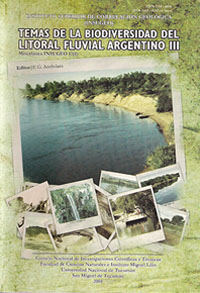Miscelánea 17 (1)
Wetlands modification and wildlife habitat suitability: can capybaras survive in a matrix of poplar and willow afforestations?
Rubén D. Quintana | Fabio A. Kalesnik
Para adquirir la publicación haga click aquí
Resumen
WETLANDS MODIFICATION AND WILDLIFE HABITAT SUITABILITY: CAN CAPYBARAS SURVIVE IN A MATRIX OF POPLAR AND WILLOW AFFORESTATIONS? El bajo delta del río Paraná constituye una región altamente modificada desde los comienzos del siglo XX debido, principalmente, a la actividad forestal. En este trabajo se describe de qué manera esta actividad ha modificado su paisaje, particularmente en el régimen hidrológico y se explica como estos cambios afectan la conservación del carpincho en términos de cambios en la aptitud de hábitat. En esta región se desarrollan dos tipo de prácticas forestales. La primera involucra un manejo del agua dentro de la forestación que consiste en la construcción de canales y zanjas de drenaje a fin de acelerar la salida de los excedentes hídricos hacia los cursos principales. Esto ha dado como resultado alteraciones positivas en el paisaje original de las islas incrementando la aptitud de hábitat para los carpinchos en términos del incremento de zonas de pastoreo y del porcentaje de interfases tierra-agua y el mantenimiento de parches de pajonales. La segunda consiste en forestaciones en las cuales las plantaciones se encuentran totalmente rodeadas por un dique protector de las inundaciones. En este caso, el drenaje completo del área interior de los diques y la eliminación de los pajonales originales afectan drásticamente la aptitud de hábitat para este roedor, debido particularmente a la pérdida de los cursos de agua dentro de la plantación. Esto indica que para que un manejo conjunto de especies de fauna silvestre y actividades productivas tradicionales se requiere tener en claro que elementos del paisaje deben ser preservados o mejorados a fin de garantizar la permanencia de las condiciones de hábitat para una especie en particular.
Abstract
WETLANDS MODIFICATION AND WILDLIFE HABITAT SUITABILITY: CAN CAPYBARAS SURVIVE IN A MATRIX OF POPLAR AND WILLOW AFFORESTATIONS?.The lower delta of the Paraná River region has been highly modified since the beginning of the twentieth century, mainly due to forestry. In this paper we review the ways in which forestry has modified the lower delta landscape, resulting in changes in the hydrological regime, and we explain how the latter affects capybara conservation in terms of changes in habitat suitability. Forestry practices in the study region are of two types. The first involves afforestation with water management consisting of drainage canals to eliminate excess water and channel it rapidly to the main water courses. This has led to positive alterations to the islands’ original landscape, improving habitat suitability for capybaras in terms of larger grazing areas, increased percentage of land-water interfaces and the presence of patches of freshwater marsh. The second consists of afforestation in which the plantation is totally surrounded by a dam to protect trees from floodwater. The complete drainage of the area behind the dam and systematic elimination of the original marshes drastically affect habitat suitability for capybara, basically due to the lack of water bodies. This indicates that successful compatible management of wildlife and traditional productive activities requires a clear idea of which landscape elements must be preserved or improved in order to guarantee habitat for any particular species.




